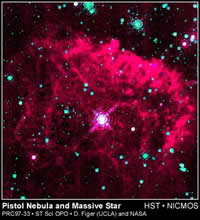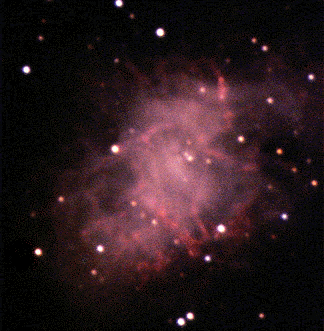The basic forces in nature
Contemporary Physics Education Project
Fundamental Forces
There are four forces in the Universe: strong, weak, electromagnetic and gravity. You may be most familiar with gravity. Gravity is what holds you and your dog to the surface of this planet!
The other forces may be less familiar to you, but they are very important! For example, the electromagnetic force holds electrons in orbit around the nucleus of an atom. We need these atom parts to be held together because we're made of atoms!
FUNDAMENTAL FORCES
| Interaction |
Relative Strength |
Range |
Mediating Particle |
|
| Strong |
1 |
Short |
Gluon |
|
| Electromagnetic |
0.0073 |
Long |
Photon |
|
| Weak |
10-9 |
Very Short |
W,Z |
|
| Gravitational |
10-38 |
Long |
Graviton |
|
Table courtesy of University of Guelph, Guelph, Ontario (Cananda)
You might also be interested in:

Atoms have two main parts: a massive nucleus at the center and a swarm of fast-moving electrons around it. The nucleus is made up of protons and (usually) neutrons. Almost all of the mass (more than 99%)
...more
Gravity is one of the universal forces of nature. It is an attractive force between all things. The gravitational force between two objects depends on their masses, which is why we can really only see
...more
The protons in the nucleus of an atom have a positive charge. If protons come near each other, they are usually pushed apart by the electromagnetic force. (Remember, opposite charges attract, but like
...more
The Sun acts like it has a big magnet in the middle of it. We call this the Sun's magnetic field. The Sun's magnetic field has a fancier name, the Interplanetary Magnetic Field (IMF). This just means that
...more
In the basic Hydrogen fusion cycle, four Hydrogen nuclei come together to make a Helium nucleus. This is the simple version of the story. There are actually electrons, neutrinos and photons involved in
...more
Fusion in the core of stars is reached when the density and temperature are high enough. There are different fusion cycles that happen in different phases of the life of a star. These different cycles
...more
Neutron capture can occur when a neutron approaches a nucleus close enough for nuclear forces to be effective. The neutron is captured and forms a heavier isotope of the capturing element. When the new
...more
A Supernova is a very massive star that explodes at the end of its life. The supernova is where the heavy elements (heavier than iron) are made.
...more















